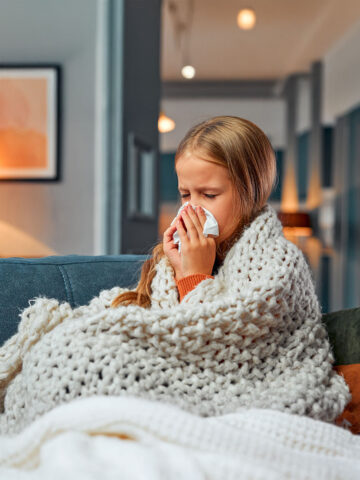Your child has been coughing, sneezing and running a temperature. Is this the common cold, or could it be something more serious like pneumonia?

On the surface, symptoms can be similar. But Dr. Jonathan Auth, a CHOC pediatrician, says parents can look for five key signs that indicate their child may have developed bacterial pneumonia, an infection of the lungs:
1. Grunting
Listen to the child’s breathing. A consistent grunting noise associated with his breaths is typically a warning sign, Dr. Auth says.
2. Flaring
Pay attention to the child’s nostrils. Do they flare open and closed as she breathes? This can be a sign that breathing is impacted deeper in the lungs.
3. Retractions
Closely examine a child’s torso where the abdomen meets the rib cage. As he breathes, look for a sucking motion of the skin. Referred to as a retraction, this movement indicates that the child is having difficulty breathing.
4. Late onset fever
A fever that appears more than three days after cold symptoms first surfaced could be an indicator of pneumonia or another secondary infection, Dr. Auth says. Generally, if a fever accompanies a cold, it typically will arise at the beginning of the illness. A late fever is often a sign of trouble.
5. Increased respiratory rate
Look for more rapid breathing in your child. This varies by age, but Dr. Auth says a good rule of thumb is that an infant younger than 2 months taking more than 60 breaths per minute; a baby aged 2 to 11 months taking more than 50; and children older than 1 taking 40 or more breaths per minute should be evaluated by a pediatrician.
How to stop a cold from turning into pneumonia
There is no sure-fire way to ensure a pneumonia doesn’t follow a cold, but parents can take a few steps to minimize the possibility.
First, keep the child hydrated through liquid consumption and a humidifier, Dr. Auth says.
The goal is to ensure the body’s mucus secretions do not dry and thicken to create a breeding ground for the bacteria that causes pneumonia, he explains.
Hydration also keeps the tissue that lines the body’s cavities, like nostrils, from drying out. Dry mucosal lining can crack, which makes it easier for bacteria to enter and cause illness, Dr. Auth says.
Children with asthma and a history of allergies should also take steps to control inflammation and allergens in the home.
For more health and wellness resources from the pediatric experts at CHOC, sign up for the Kids Health newsletter.
Find a CHOC Primary Care Pediatrician
From babies to teens, pediatricians from CHOC’s Primary Care Network partner with parents to offer immunizations, sick visits, sports physicals and more.





